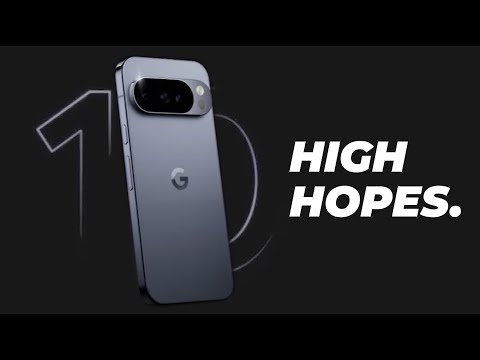
The Pixel 10 series is just around the corner. August 20th is when Google will fully reveal the upcoming Pixel lineup. And as a Pixel user for many years, I do have a long list of features and improvements that I really wish to see coming with the newer models. So, let's talk. Same as every year, Google's latest flagship is my daily driver up until the next one comes, and the 9 Pro XL is no exception. After almost a year, there are a lot of things I like about this phone. But at the same time, there are a lot of missing things based on my experience with other flagships like the 16 Pro Max, the S25 Ultra, and others.
That's why I decided to make this video to share my thoughts and what I would love to see in my next Pixel 10 Pro XL. [Music] My biggest issue with the 9 Pro XL always been the camera, especially the videos. Starting with the blur videos, also known as cinematic videos, it's the worst across the board. It's limited to 1080p at 24 frames per second with no front camera support. In contrast, Samsung and Apple can record up to 4K 30 with front camera support. So, I would love to see things improving with the 10 Pro XL. Secondly, slow motion videos.
Google left behind this feature for many years. It's still maxed out to 1080p, 240 frames per second, same as the Pixel 4 XL, which is 5 years older than the 9 Pro XL. It's about time to jump into the 4K 120fps slow-mo videos with the Pixel 10 to match Samsung and the Apple, or at least offer the same anistant slow-mo feature Samsung released last year that can convert any video into a slow-mo using AI, and it looks amazing. And the same applies to the active video stabilization, also known as action mode, which is still limited to 1080p 30fps, same as the Pixel 5.
While Samsung and Apple flagships can record up to 2.5 and 2.8K at 60 frames per second, respectively, the lens switching is another area where Pixel phones do struggle with for a long time. As you see, it's very sluggish, especially when switching between the wide and telephoto. Thankfully, video boost do solve this problem, but it's not ideal to use it with every recording and wait for hours until Google servers enhance the video, which will take us to the video boost feature itself. It does make a massive difference in quality, but it's still limited. It doesn't work with the ultrawide and the front camera, which needed the most because of their subpar video quality, and if you are somewhere with a slow internet connection, you will end up waiting for ages to get your videos processed.
I really hope Tensor G5 in the Pixel 10 will finally be able to enhance videos locally and support all lenses, not just the main and the telephoto. Lastly, there are two features that I would love to see coming. The log and the multi- camera video recording. Those two features are available on Samsung and other Android devices for years, and it's about time to see them on Pixel phones. So, that's it when it comes to the videos. Now, let's talk about the photos. If you are a Pixel user, I'm sure that the first thing that comes to your mind is the portrait photos. No matter how many years pass or how better is the hardware, the subject isolation is a complete mess. I did many camera comparisons hoping to see an improvement, but unfortunately, you are still in square one. The competition is miles ahead now, and Google is turning a blind eye as if this feature doesn't exist. Not to mention that only Pixel phones don't offer telephoto or 5x portraits like others. If the Pixel 10 is going to suffer from the same problems, I will be extremely disappointed.
Moving to normal photos, I think the Pixel 9 models lost the Pixel identity. Every time I open the camera app, the viewfinder looks perfect. But after snapping the shot, the image processing mutes the colors and brightens the shadows, which results in a flat, lifeless image. So, I would love to see Google reverting back to its original identity that we loved for years. On a side note, I suggest if Google can give us the option to create reusable image profiles or styles by adjusting the settings and save it for future use instead of adjusting the camera every single time to get a specific look, which is similar to Apple's photographic styles. So, these are all the camera improvements I would love to see with the Pixel 10.
Now, let's talk about the performance and battery. We already know a lot about Tensor G5, which makes me very optimistic. Based on the leaks, it's now manufactured by TSMC on the same 3 nanometer fabrication used in the A18 Pro chip. So hopefully we will see a big performance and efficiency gains combined with the new imagination GPU that supports rate tracing and GPU virtualization. Additionally, the TPU or tensor processing unit responsible for machine learning is 40% larger than the one used in G4. Overall, the spec sheet looks a lot better than the 9 Pro XL in many ways, but numbers don't always translate into an actual performance.
So, we have to wait for the real life testing. My experience with Tensor G4 is mainly positive. But there are four points that I hope to see addressed with Tensor G5. The first one is the phone consumes a lot of battery and gets noticeably warm, specifically in video calls, which is something I talked about in my battery comparison with the S25 Ultra. The 9 Pro XL consumed 25% battery and the temperature reached 48.8° after 1 hour on cellular data, while the S25 Ultra consumed 19% and the temperature was at 45.3° under the same conditions.
In contrast, Tensor G4 was cooler than the Snapdragon 8 Elite in five tasks out of seven and about the same in the YouTube task. So, it seems like video calling is the only exception. The second issue I had with Lensor G4 is the standby battery usage. It's not too bad, but the Snapdragon 8 Elite and the A18 Pro chip are definitely better. So, hopefully TSMC's 3 nanome fabrication will do the trick. The third point is the RAM management. The software kills the apps running in the background really, really fast.
Sometimes apps reload in a matter of seconds, which is very annoying. I don't know why that's the case, as reloading apps consumes more battery than keeping them running in the background. But maybe Google has another opinion. Either way, a better RAM management is certainly needed. Plus, adding the ability to keep apps open in the background like One UI will make things even better. Lastly, we need a faster storage like any other flagship. Google is stuck with the outdated UFS 3.1 for a long time, while other manufacturers are now using UFS 4.0 or higher. So, that's it. When it comes to performance, battery-wise, Tensor G4 was consistently ranging between 7 to 7.5 hours of screen on time on cellular data, which is about 52 minutes worse than the S25 Ultra in my battery comparison.
It's not far behind and good enough to make it till the end of the day, but it's not as impressive as the 9 plus hours of the OnePlus 13 or the 16 Pro Max before Apple destroys it with liquid glass. So, there's definitely a room for improvements, but what really lacks behind is the charging speed. Almost every Chinese phone in the market surpasses the 37 and 15 Wired and wireless charging speed of the 9 Pro XL by a big margin, and it's about time for Google to step up the game in this area. But the leaks suggest similar charging speeds this year, which is a bummer. I personally would love to see 45 plus watts wired and at least 25 watts wireless. So, let's wait and see. Overall, in the performance and battery, I didn't have any major complaints with Tensor G4, and it was good enough to finish all my daily tasks without a problem, but it needed some refinements in certain areas that I think Google will be able to address with Tensor G5. And now let's talk about the display.
In this area, Pixel phones had amazing displays for many years, but I'm only looking for some minor improvements to enhance the overall experience. First, I would love to see smaller bezels. The thinner bezels of the 16 Pro Max and the S25 Ultra did enhance the overall look. So, I would like to see Google doing the same, but don't expect this to happen as the leaks suggest that the Pixel 10 Pro and Pro XL will share the same display sizes and bezels. The second feature is the higher PWM dimming that might come to the Pixel 10 as per the leaked specs which will help those who have sensitive eyes. And lastly, I would love to see the ambient EQ feature making its way back which dynamically changes the screen white balance to match the environment around you. I can't believe that we had this feature in the Pixel 4 XL 5 years ago, then Google decided to kill it forever. Every flagship has a similar feature like Apple's True Tone or Samsung's adaptive color tone. These are my most anticipated features.
Other than this, I think Google nails the display in other areas like the quality, colors, brightness, and durability. Some people might say, "What about the anti-reflective glass like Samsung phones?" I used to think the same, but in reality, once I install a glass screen protector, it loses its value. So, I would rather go for an anti-reflective screen protector to provide both the protection and better visibility.
And that's why I don't have this feature on my list. And the last chapter in this video will include some random improvements that I wish the Pixel 10 models will get. First, Maxafe support, especially in first party accessories. I personally like Google's accessories and cases, but because I rely on Maxafe holders and the chargers, I end up sticking these ugly rings or metal sheets to Google's cases, which is not the best solution, or look for third party accessories that support the feature. Having magnets in the phone is not a priority for me as I have my phone covered most of the time, but it will be a nice to have feature for those who uses skins or no cases. The second one is to get better speakers.
Pixel phones do have good speakers, but they always lacked behind the iPhone, especially the 16 Pro Max. That blew my mind by how loud and clear the sound is. Third, the devices availability. Like every year, Google doesn't take any steps towards the expansion in the Middle East or Africa, while its rivals cover pretty much the entire globe. Why Google is the only one that has a problem, only God knows. And the same applies to the software features. A lot of the Pixel exclusive features didn't make their way to most of the countries like call screening, hold for me, car crash detection, and many more, but I will leave this one for another video. By this, I covered all the features, improvements, and hardware changes I would love to see coming to the Pixel 10 series. Please let me know in the comments the most important changes you want to see. But for now, thanks so much for watching and see you in the next.


